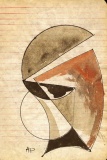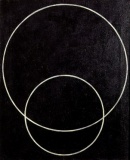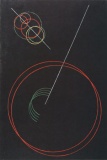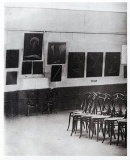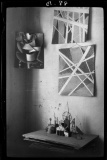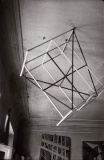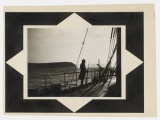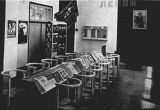Difference between revisions of "Alexander Rodchenko"
(→Works) |
|||
| Line 49: | Line 49: | ||
[[Category:Constructivism|Rodchenko, Alexander]] | [[Category:Constructivism|Rodchenko, Alexander]] | ||
| + | [[Category:Productivism|Rodchenko, Alexander]] | ||
__NOTOC__ | __NOTOC__ | ||
Revision as of 17:05, 25 December 2012
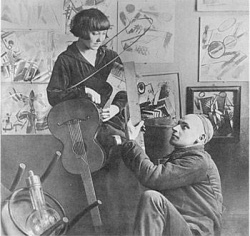 With Varvara Stepanova, 1920s. | |
| Born |
December 5, 1891 Leningrad, Russia |
|---|---|
| Died |
December 3, 1956 (aged 64) Moscow, Soviet Union |
Born 1891 in St Petersburg to a working class family. 1909 after the death of his father his family moves to Kazan. Studies at the Kazan School of Art under Nikolai Feshin and Georgii Medvedev, and at the Stroganov Institute in Moscow. In Kazan school meets Stepanova whom he subsequently marries. 1915 first abstract drawings, influenced by Malevich's Suprematism. 1916 participates in 'The Store' exhibition organized by Tatlin, who was another formative influence in his development as an artist. 1917-18 designs the wall lamps for the Café Pittoresque. Late 1910s, produced "lineist" nonobjective canvases and linocuts, rejecting Kandinsky's thesis from his "On Line" essay (1919), in which he saw the line as "a highly revelatory material for primitive graphic expression." 1919-20 active member of Zhivskulptarkh experimental group. 1920 appointed Director of the Museum Bureau and Purchasing Fund (of the Museum of Painterly Culture, MZhK) by the Bolshevik Government, responsible for the reorganization of art schools and museums and acquisition of artworks on behalf of the Russian republic (between the summer 1918 and December 1920 the Bureau bought almost 2000 works of 400+ contemporary artists for 26 million rubels[1]). 1920 to 1930 teaches at VkHUTEMAS. 1921 joins Productivist group, which advocates the incorporation of art into everyday life. Gives up painting in order to concentrate on graphic design for posters, books, and films. Deeply influenced by Vertov, works with him intensively in 1922. Impressed by the photomontage of the German Dadaists, he begins his own experiments in the medium, first employing found images in 1923, and from 1924 on shooting his own photographs as well. 1923 his first published photomontage illustrated Mayakovsky's poem, About This. 1923 to 1928 collaborates closely with Mayakovsky (of whom he takes several striking portraits) on the design and layout of LEF and Novy LEF journals; using many of his photographs as covers. His images eliminated unnecessary detail, emphasized dynamic diagonal composition, and were concerned with the placement and movement of objects in space. Throughout the 1920s Rodchenko's work was very abstract. 1930s, with the changing Party guidelines governing artistic practice, he concentrates on sports photography and images of parades and other choreographed movements. 1928 joins the October circle of artists but is expelled in 1931 being charged with "formalism". Late 1930s returns to painting, 1942 stops photographing. 1940s produces abstract expressionist works. 1940s continues to organize photography exhibitions for the government. Died 1956 in Moscow.
Works
Literature
- Camilla Gray, The Russian Experiment in Art, 1863-1922, 1962.
- Stephen Bann (ed.), The Tradition of Constructivism, Viking Press, 1974.
- John E. Bowlt (ed.), Russian Art of the Avant-Garde: Theory and Criticism, 1902-1934, Viking Press, 1976.
- Margit Rowell, Angelica Zander Rudenstine, Art of the Avant-Garde in Russia: Selections from the George Costakis Collection, The Solomon R. Guggenheim Museum, New York, 1981.
- Brandon Taylor, "Aleksandr Rodchenko’s Lines of Force", Tate Papers, 2009.
See also
- Varvara Stepanova
- Russia#Avant-garde
- Media art in Central and Eastern Europe#Constructivists, Futurists
- Media art in Central and Eastern Europe#Photography
External links
- http://konstruktivizm.com/category/alexander-rodchenko
- Rodchenko & Popova exhibition in Tate London, 2009
- http://artblart.wordpress.com/2011/08/09/exhibition-alexander-rodchenko-revolution-in-photography-at-fotomuseum-winterthur-zurich/
- http://masters-of-photography.com/R/rodchenko/rodchenko.html
- http://calitreview.com/2842
- http://www.e-flux.com/journal/view/132
- http://www.chtodelat.org/index.php?option=com_content&view=article&id=558%3Aproductionism-art-of-the-revolution-or-design-for-the-proletariat&catid=204%3A01-25-what-is-the-use-of-art&Itemid=455&lang=en
- Rodchenko on Wikipedia
